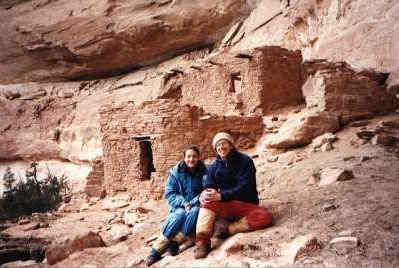|
||||||||||||||||||||||||||||||||||||||||||
 |
I've always been fascinated with the magic flute player, Kokopelli. The ancient people of the Americas chipped his picture into the rocks all the way from Peru to Colorado. Hiking in remote canyons, I would often come across Kokopelli on cliff walls. I knew that the modern pueblo people of the Southwest, including the Hopi of Arizona, say that the hump on Kokopelli's back is a bag of seeds that he would bring to villages scattered far and wide. His magic flute brought the rain necessary to sprout the seeds. One day, staring at one of these pictures in stone, I got to daydreaming. What if Kokopelli is still alive, I thought. He's thousands of years old, but he's still alive! What if I were to write a story in which he comes into the life of a modern kid? Wow! With a magic character who's thousands of years old, I'd be writing a fantasy novel. Your main character, Tepary Jones, is growing up on a seed farm. Are there really farms dedicated to preserving rare seeds? I visited one in New Mexico before I started writing. That's where I got the idea of Tep growing up on such a farm. A mysterious man who calls himself “Mr. K.” has been sending them some amazing seeds . . . perhaps he'll come visit the farm one day. How in the world did you get the idea of Tep getting trapped inside the body of a packrat? I needed, early on, to let the reader know that this is a fantasy. After all, we're going to meet a character who's thousands of years old. Well, I didn't know how I was going to deal with this. Right when I needed an answer, I had a lucky accident. My pickup truck hadn't been running very well, so I drove it into town and asked my mechanic to take a look at it. As soon as he popped the hood he started laughing. My motor was covered with a huge nest made out of sticks, bones, rocks, and weeds! “You've got packrats!” he announced, still laughing. A light bulb went on in my head—here was the key to my story. You see, I knew that packrats lived in the cliff ruins all over the Southwest. My character, Tep, could be visiting his favorite cliff ruin during an eclipse of the moon, and something magical would happen to him. After he plays the ancient flute, every night he turns into a packrat! You can see what these ruins look like in a photo on this page of my niece, Sarah, and me on a hiking trip.
Is that deadly virus in the story real? Hantavirus is very real. Right when I was writing the book, the newspapers were full of stories about people in the Four Corners area of Colorado, New Mexico, Arizona, and Utah, dying from it. It's carried by deer mice and it's very scary. What else is real? Unfortunately, the pothunters are real. These criminals who pillage ancient graves for pottery and other artifacts are finally being put in jail, but not enough of them. It's also real that scientists like Tep's mom are studying the middens of packrats for clues to the way the ancient people utilized their environment. Archeologists are still trying to solve the mystery of why these people abandoned their homes, and where they went. What about Ringo? Is there such an animal as a ringtail? Yep, and they're incredible camp robbers. We know from experience. Are you interested in gardening yourself? I am, and I hope some of Tep's love of gardening rubs off on my readers. I grew up gardening with my dad. When Tep talks about how much he enjoys planting seeds, about waiting for them to sprout, about the excitement of seeing them break the surface, that's me! I especially loved to grow stuff that got big—tomatoes, cucumbers, melons, and pumpkins. You can see why I was enchanted in the first place with Kokopelli, the seedbearer. If some kids plant a few seeds on account of reading Kokopelli's Flute, that would make me feel mighty good indeed. |
|



